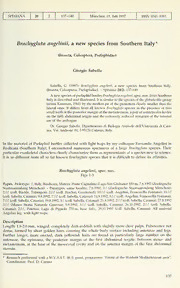
Brachygluta angelinii, a new species from Southern Italy. (Insecta, Coleoptera, Pselaphidae) PDF
Preview Brachygluta angelinii, a new species from Southern Italy. (Insecta, Coleoptera, Pselaphidae)
SPIXIANA Headclearlywider(0.40-0.42mm)thanlong (0.30-0.31 mm)andonlyslightlynarrowedanteriorly (width of the frontal lobe: 0.24-0.25mm). Eyes well developed but only slightly prominent, temples roundish and distinctly longer than the eyes. Between the eyes, only two interocular pits are found, while the major part of the Bmchygluta species bears three pits. Pits large, densely pubescent and profound,separatedbyaslightlyconvexareaofthecephalicsurfacesimilarinwidthtooneinterocular pit.PenultimatepalpSegmentenlarged,butdistallyclearlynarrowerthanthebaseofthelarge,ovoidal terminal segment. Surface of head shiny wherever no traces of punctuation are present. Antennae (Fig.1) verylong(1.10-1.15mm),scapusandpedicellusslightlyenlargedwithrespecttothefuniculus Segments.Scapusabout1.5timeslongerthanwide,pedicellusslightlvlongerthanwide,segments3,4, 6,and7nearlyofthesameshape,abouttwotimeslongerthanwide,whilesegment5ismorethantwo timeslongerthanwideandsegment8onlyslightlylongerthanwide.Antennalclubisformedbythree Segments, all longer than widebut gradually enlarged from segment9 towards segment 11; segment 11 only slightly shorter than segment9 and 10 taken together and about 1.5 times longer than wide. Pronotum slightlylonger (0.42-0.45mm) thanwide (0.40-0.41 mm) and onlyslightlybroaderthan head,themaximumwidthisjustbehindmiddle;itslateralmarginsarealmostparallelposteriorly,but more clearly narrowed anteriorly. The pronotum bears three not very evidentbasal pits, the median onelessnoticeablethanthetwolateralones,likeinReichenbachia.AmongsttheBrachyglutaoftheItalian fauna only ß. glolndicollis has this characteristic. Tegument sliiny without punctuation. Elytra broader (0.76-0.80mm) than long (0.66-0.68mm), with a visiblebut not particulary promi- nent humeral callosity and two clearly visible basal pits on each side. The medial pit continues in a suture linethatalmost reaches the apex ofthe elitra, the lateral pitis extended into a discal line that reaches the distal halfofthe elitra. Surface covered by sparsebig pores. Ist abdominal tergite very long (0.41 mm) and slightly narrowed posteriorly. Abdominal basal carinaeveryshort,separatedbyadistancebroaderthanhalfthewidthofthetergite.In6theposterior margin ofthe Ist tergite is indented as shown in fig. 2. The disc ofthe 2nd tergitebears an elevated medial carina,which is largerposteriorlyand progressively narrowed anteriorly. 5thsternitebears a pair ofsemicircular lateral keels (Fig. 2). Legs very long and thin, their trochanters, femora and tibiae inarmed. Metasternum not grooved, along its medial line there are two series of laterally bent hair. The posterior margin of the metasternum bears two ventrally directed small teeth (I do not know any Brachygluta species that has such a character). mm The aedeagus (Fig. 3) is 0.23-0.25 long with short and stumpy parameres bearing two big subapicalbristles and a large trasparentapicallamella. Armatureofinternal sacvery simple, formed by a big slightly medially curved tooth, accompained by another smaller and poorly visible tooth. 9 unknown. I dedicate this interesting species to Fernando Angelini, the well-known coleopterologist from Francavilla Fontana (Brindisi),whohascontributed greatlytotheknowledgeoftheColeopterafauna of Southern Italy. Discussion The genus Brachygluta Thomson, 1861 is distributed with 93 species (Newton & Chandler 1989: 42) mainly in the Holarctic region, in the Afrotropical region, and in Burma. The Palearctic regionis the riebest with 67 species (some of which are divided into numerous subspecies), distributed in whole Europe, throughout North Africa (except for Libya, probably due to lack of research) and in Asia including the Arabic peninsula as its southern limit, reaching Kazakistan to the northand Turkestan and Iran as its eastern border, despite Besuchet is presently describing (personal communication) a new species from Pakistan. No species are known from India, China and Japan. AmongthepalaearcticBrachygluta,B.angelinii,spec.nov.iscomparableonlytothosethathave 36 withmodified abdominal tergites. Almostall thesespecies havebeenassembled byJeannel (1956) in thegenus Brachyglutodcs (todayconsidered synonymofBrachygluta); mostofthemhavebeendistrib- uted tomoreorlesshomogenousand completespeciesgroups: haematica, ragiisae, leprieuri,schueppeli, helferi, excavativentris andglobulicollis. The systematic assessment ofall these groups needs revision. 138 Figs 1-3. Brnclii/gliitn angelinii, spec. nov., Holotype. 1. Rightantenna. 2. Abdomen. 3. Aedeagus, dorsal view. ß. angelinii cannot be inserted within any of the above mentioned groups. However, due to its uniform reddish colour, long and thin antennae and legs and mainly for the median pit of the pronotumthatisclearlysmallerthanthelateralones,itissimilartothespeciesoftheglobidkollis-group (sensuKaraman1961),includingthefivesubspeciesofß.globiilicollis(MulsantetRey,1861),B.colchicn (Saulcy, 1876) and ß. inmica (Saulcy, 1876). However, ß. angeluüi is distinctly different from all Brachyghita species in the presence of two small teeth at the posterior margin of the metasternum and a pair of semicircular lateral keels at the fifth abdominal sternite. Also theparticularmorphologyoftheaedeaguS, mainly thereduced armatureof the internal sac separes ß. angelinii from all known Brncln/glnta species. Additional field work in the Balcanic peninsula, in Turkey and in SW Asia, areas poorly studied untilnow, surelywillpermit the discoveryofnew species. The study ofthis additional material will contribute to a more complete understanding of the relations between the Brachyghita species and species groups. Riassunto L'autore descrive e figura una nuova specie di Bmchygluta, B. angelinii, spec. nov. deiritalia meridionale. La nuovaspecieenettamenteseparatadallecongenericheperalcunicaratteriesoscheletriciesclusivi(presenzasul margineposterioredelmetasternodiduedentinirivoltiinbasso,marginilateralidelquintosterniteaddominale allargatiasemicerchio)eperlamorfologiadell'edeago(conparamericortietozziedarmaturadelsaccointerne ridotta ad undentericurvoed ad unaltropiü piccoloaddossatoal primo).ß. angeliniispec. nov.ecomunque raffrontabile con le Brachyghita del gruppo globulicollis {sensu Karaman, 1961) essenzialmente per la fossetta medianadel pronotonettamente piü piccola dellelaterali. 139 References Jeannel,R.1956.LesPselaphidesde1'AfriqueduNord.Essaidebiogeographieherbere.-Mem.Mus.Nat.Hist. Nat.,Paris,Ser.A,Zool. 14: 1-233 Mulsant,M.E.&C.Rey1861.DescriptiondequelquesColeopteresnouveauxoupeuconnus.-Opusc.ent.,Paris 12: 47-92 Newton, F. N. & D. S. Chandler 1989. World Catalog oftheGenera ofPselaphidae (Coleoptera). -Fieldiana, Chicago,n. s. 53: 1-93 Saulcy, F. (de), 1876. SpeciesdesPaussides,Clavigerides, PselaphidesetScydmenidesdel'Europeetdepays circonvoisins.-Bull.Soc.Hist.nat.Metz,HerneSer. 14: 25-100 Thomson,C. G. 1861.SkandinaviensColeoptera,vol. 3-Lund: 1-278 140
